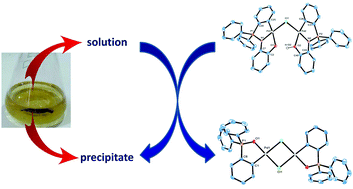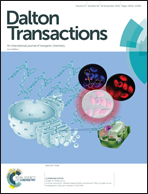Palladium iminophosphorane complexes: the pre-cursors to the missing link in triphenylphosphane chalcogenide metallacycles†
Abstract
Herein we report on the synthesis, characterization and the ensuing chemistry of iminophosphorane palladacycles. Treatment of Ph3P![[double bond, length as m-dash]](https://www.rsc.org/images/entities/char_e001.gif) N-(2-OHC6H4), 1, with sodium tetrachloropalladate gives 2 with the ligand as terdentate [C,N,O] allowing for only one μ-Cl ligand bonding the metal centers, resulting in a dinuclear complex. Treatment of 2 with PPh3 gives the mononuclear complex 3, whereas the reaction of 2 with diphosphanes Ph2P(CH2)nPPh2 in 1 : 2 ratio gives mixtures of 4 and 5 (n = 2) and 6 and 7 (n = 3). From them, the mononuclear complexes 4 and 6, and the dinuclear compounds, 5 and 7, were obtained with the parent ligand as bidentate [C,N]. The former two are of zwitterionic nature void of any counterion, with the phosphane ligand in the chelating mode. In a remarkable case of chemical serendipity, a solution of 2 left to stand produced crystals of complex 8: this is the missing link in the series of triphenylphosphane chalcogenide metallacycles. The experiment is repeatable; however, direct metallation of triphenylphosphane oxide was not possible.
N-(2-OHC6H4), 1, with sodium tetrachloropalladate gives 2 with the ligand as terdentate [C,N,O] allowing for only one μ-Cl ligand bonding the metal centers, resulting in a dinuclear complex. Treatment of 2 with PPh3 gives the mononuclear complex 3, whereas the reaction of 2 with diphosphanes Ph2P(CH2)nPPh2 in 1 : 2 ratio gives mixtures of 4 and 5 (n = 2) and 6 and 7 (n = 3). From them, the mononuclear complexes 4 and 6, and the dinuclear compounds, 5 and 7, were obtained with the parent ligand as bidentate [C,N]. The former two are of zwitterionic nature void of any counterion, with the phosphane ligand in the chelating mode. In a remarkable case of chemical serendipity, a solution of 2 left to stand produced crystals of complex 8: this is the missing link in the series of triphenylphosphane chalcogenide metallacycles. The experiment is repeatable; however, direct metallation of triphenylphosphane oxide was not possible.



 Please wait while we load your content...
Please wait while we load your content...